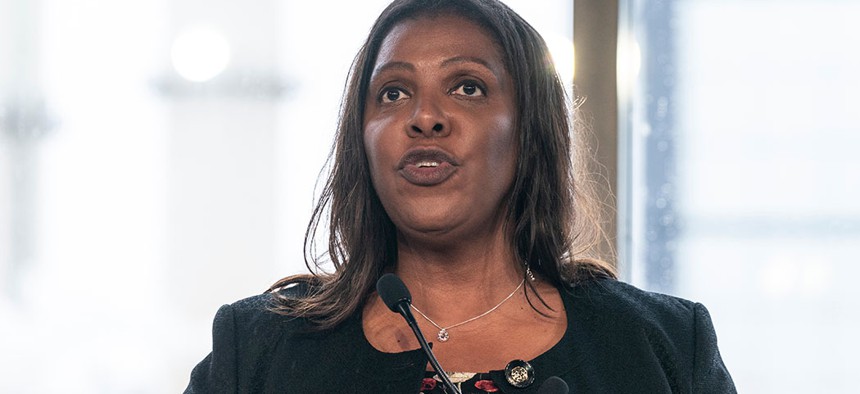New York’s case against the Trump Foundation was unusual.
Last month, President Donald Trump admitted to misusing the charitable funds to boost his presidential campaign, pay off his companies’ debt and purchase a $10,000 portrait of himself. The admission came with what experts called an unprecedented punishment for such a foundation – he was ordered to pay $2 million in damages, to be sent to eight charities, and agreed to strict oversight if he ever attempted to head a nonprofit again.
But what made the case unique wasn’t just the president’s rare admission of guilt. It was the fact that the case was taken up against such a nonprofit, which then faced major penalties.
“I would argue that if Trump had not run for president, this foundation would never have come under scrutiny,” Jim Fishman, professor at the Elisabeth Haub School of Law at Pace University, told City & State. “It took a Pulitzer Prize effort by David Fahrenthold of The Washington Post to really dig out the information involving the Trump Foundation.”
Comparatively few cases are taken against fraudulent nonprofits, even in New York, which has some of the most robust staffing to oversee charities in the country. This includes foundations, which hold about $151 billion in total assets in the state. Most investigations in the state are resolved outside of court.
One comparative example is fairly recent. The attorney general’s office announced a settlement in May over a case against the Richenthal Foundation, which faced similar allegations to the Trump Foundation. Broadway producer David Richenthal had to pay back $500,000 he took illicitly took from the foundation, which mostly funded theater groups. Another grant-making organization, the Victor E. Perley Fund, had to pay a $1 million settlement in 2015 after its board allowed its president, Richard Basini, to use its funds to purchase a $1 million Southampton home. The Homeland Foundation had to pay up $700,00 later that year as well because its officers misused funds for personal use. New York State Attorney General Letitia James is also investigating the charitable arm of the National Rifle Association.
But many comparable foundations may be going under the radar, and not just in New York.
“It is not a priority,” Elizabeth Boris, founding director of the Center on Nonprofits and Philanthropy at the Urban Institute, told City & State. “The AG is after bigger fish, big corporations. A lot of nonprofits are under $100,000, how much damage can they do, in a way.”
Larger nonprofits, particularly hospitals and higher education institutions, more frequently are the target of scrutiny, Boris said. Attorneys general often focus on particularly egregious cases and outright scams.
“It’s good publicity for AGs to go after totally fraudulent charities,” Fishman said. The New York Attorney General’s office has pursued cases against the National Children’s Leukemia Foundation and the Disabled Veterans National Foundation, the latter resulting in a $25 million settlement.
Lack of resources is a major problem for enforcement against nonprofits, particularly in other states. One-third of jurisdictions reported having less than one full-time employee dedicated to charity oversight, according to one 2016 Urban Institute study, and more than half said they had fewer than three. The New York Attorney General’s Charities Bureau currently has a staff of 75, mostly likely due in part to New York’s sizeable nonprofit sector.
Poor funding and staffing is also a problem at the Internal Revenue Service, which approves tax-exempt status for organizations and monitors behavior that may threaten that status. The U.S. Government Accountability Office found that the number of IRS employees dedicated to tax-exempt groups fell by about 5% from 2010 to 2013.
“Given that charities generally do not generate much in the way of money for the IRS itself, in terms of collecting revenue for the country, the IRS has never particularly put a lot of money into charity either,” Philip Hackney, a professor at the University of Pittsburgh School of Law who previously worked in the office of the chief counsel of the IRS, told City & State. The agency does also collect and publish tax forms from nonprofits, which provides the public the means to investigate suspicious behavior as well.
The general lack of priority around overseeing nonprofits means there’s little sense of how many engage in illicit behavior. However, Fishman argued that smaller foundations are more likely than larger and more well-known ones to violate the law.
“I think what happens with many private foundations is that an individual sets them up, they use the family lawyer, who knows nothing about the private foundation rules, and they just do what they think they’re allowed to do,” he said.
Private foundations – which don’t necessarily encompass all grant-making institutions – face stricter rules than nonprofits registered as public charities. They must pay out at least 5% of their assets for charitable purposes each year and have strong prohibitions on self-dealing, which the Trump Foundation had violated.
“I think most foundations are the most compliant of taxpayers because the excise taxes that are imposed if you violate the private foundation rules, the responsible foundations will adhere to the law, as complex as it is,” Fishman said.
Trump and his defunct foundation should pay excise taxes to the IRS, Hackney has argued. But given the already weak oversight – especially when it comes to the president – he remains pessimistic.
“We know historically the IRS has hesitated from taking those types of actions,” he said.


